Choosing the best tires for your Kawasaki KLR650 is a crucial decision that can significantly impact your riding experience.
With a wide range of options available, each offering unique features and benefits, selecting the right tires requires careful consideration of factors such as terrain compatibility, tread pattern, durability, and riding style.
There is no doubt that the Michelin Anakee Wild is considered one of the best tire options for the KLR650 due to its exceptional versatility and performance across diverse terrain. Its updated casing design and advanced rubber compound offer superior grip and durability, making it suitable for both on-road and off-road riding.
In addition to the Michelin Anakee Wild, I’ll also discuss other notable tire options for the KLR650, including the Kenda K270 Dual Sport, TUSK Dsport® Adventure, Dunlop Tire, and OEM choices. Each tire offers its own set of advantages and considerations, catering to different riding preferences and conditions.
In this guide, we’ll explore the top tire choices for the KLR650 and provide insights to help you make an informed decision. Also, I’ll cover factors to choose the best tires for your Kawasaki KLR650 that meet your specific needs and enhance your riding experience.
Best Tires For Klr650 Comparison Side-By-Side: Table Analysis
In this comprehensive side-by-side comparison table, we evaluate the top tire options for the Kawasaki KLR650, highlighting key features, benefits, and considerations.
| Tire | Tusk Dsport® Adventure | Kenda K270 Dual Sport | Michelin Anakee Wild | Dunlop Tire | Kawasaki 1985-2016 | Shinko 705 Tire | Kawasaki 1985-2018 |
| Tread Type | Directional | Directional | N/A | Non-Directional | Non-directional | Non-Directional | Non-directional |
| On-road Performance | Good | Good | Excellent | Good | Good | Good | Good |
| Off-road Performance | Good | Good | Excellent | Excellent | Good | Good | Good |
| Durability | Excellent | Good | Excellent | Good | Good | Good | Good |
| Load Index | 65 | 71 | 54 | 54 | N/A | Approx. 65 | N/A |
| DOT Approved | Yes | Yes | Yes | Yes | Yes | Yes | Yes |
| Tube Type | Tubeless | Tube | Tubeless | Tube | Tube | Tube | Tube |
Top 7 Tire Brands For Klr650: Features, Benefits, And More
Explore the top 7 tire brands for the Kawasaki KLR650 in this detailed guide, uncovering their unique features, benefits, and more.
- Tusk Dsport® Adventure Tire: Best for the Price

The Tusk Dsport® Adventure Tire stands out as an excellent option for budget-conscious riders seeking quality and versatility. Here is a more detailed discussion including pros and cons.
Features with benefits:
Aggressive Tread Pattern:
The aggressive tread pattern enhances traction and grip on various terrains, including dirt, gravel, mud, and pavement. This ensures stability and control, allowing riders to confidently navigate both on-road and off-road conditions.
D.O.T. Compliant:
Being D.O.T. compliant signifies that the tire meets the safety and performance standards mandated by the Department of Transportation. This ensures legal compliance for street use and confirms that the tire has undergone rigorous testing for safety and reliability.
Deep 16 mm Tread Depth on the Rear:
The deep tread depth on the rear tire improves traction and longevity, particularly in demanding off-road environments. It enables the tire to maintain grip on loose surfaces, providing better handling during acceleration, braking, and cornering.
Tall Knobbies:
Tall Knobbies increase the tire’s surface area and biting edges, enhancing traction and grip on loose or uneven terrain. They help evacuate mud and debris from the tread, preventing slippage and maintaining consistent traction, especially in muddy conditions.
Rubber Compound:
The rubber compound used in the Tusk Dsport® Adventure Tire is engineered for durability and performance. It balances grip, longevity, and resilience, ensuring reliable performance across various riding conditions and terrains.
Pros:
- Designed for on and off-road;
- Price is very low;
- Long-lasting;
- Long wear in the street;
- Puncture resistant and reliable.
Cons:
- Maybe a bit noisy.
- Kenda K270 Dual Sport: Best for Year-Round Benefits

Front: https://www.amazon.com//dp/B078Z45X5H
Rear: https://www.amazon.com/dp/B07DHXQXTF
The Kenda K270 Dual Sport tires are well-regarded for their year-round performance, offering a balance between on-road and off-road capabilities. Let’s examine the features, and benefits, pros, and cons:
Features with Benefits:
DOT Compliant (40% dirt, 60% road):
The Kenda K270 tires are Department of Transportation (DOT) compliant, indicating that they meet safety and performance standards for street use. With a tread pattern optimized for 40% off-road and 60% on-road performance, these tires offer versatility for various riding conditions.
Specific Design:
The specific design of the Kenda K270 tires is tailored for dual-sport motorcycles, offering a blend of off-road traction and on-road stability. The tread pattern is optimized to provide grip and control on both dirt trails and paved roads, ensuring a confident riding experience in diverse environments.
Special Rubber Compound:
The Kenda K270 tires feature a special rubber compound designed to enhance durability and grip. This compound provides long-lasting performance while maintaining traction in various weather conditions, including wet and dry surfaces.
Directional Tread Type:
The directional tread design of the Kenda K270 tires is engineered to provide optimal performance in specific riding conditions. It helps channel water away from the tire’s contact patch, reducing the risk of hydroplaning on wet roads and improving grip in challenging terrain.
Tube-type:
The Kenda K270 tires are designed as tube-type tires, which means they require inner tubes for inflation. While tubeless tires are becoming more common, tube-type tires offer simplicity and ease of repair in the event of a puncture or flat tire.
Pros:
- Perfect traction on on-road and off-road;
- Good value for the bucks;
- Precise handling in rain;
- 6-ply rated casings;
- Additional grip off the road.
Cons:
- May struggle in mud.
- Michelin Anakee Wild: Best for Flexibility
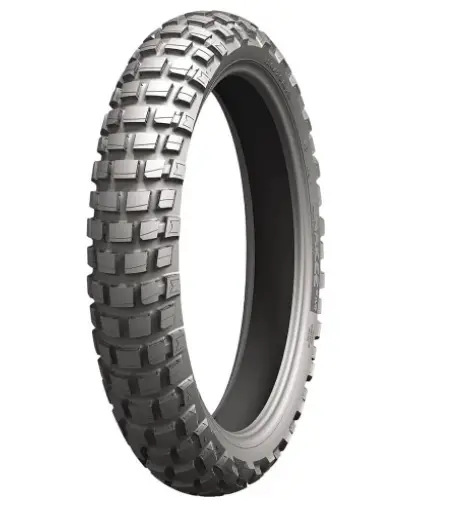
Tire:
Front: https://www.amazon.com/dp/B06XC7HN5Z
Rear: https://www.amazon.com/dp/B071L5M37C
The Michelin Anakee Wild tires are highly regarded for their flexibility, offering excellent performance both on and off-road. Let’s explore the features, benefits, pros, and cons:
Features with Benefits:
Updating Casing Design:
The Michelin An akee Wild tires feature an updated casing design that enhances durability and performance. This design optimization improves overall tire stability and longevity, providing riders with confidence and reliability in various riding conditions.
Better Grip:
These tires are engineered to deliver superior grip on both wet and dry surfaces, thanks to their advanced tread pattern and rubber compound. This enhanced grip ensures improved traction and control, allowing riders to navigate challenging terrain with ease and confidence.
Lightweight:
The Michelin An akee Wild tires are designed to be lightweight, contributing to better handling and maneuverability. This feature allows for easier control of the motorcycle, especially during quick directional changes and off-road maneuvers.
Stubborn Sidewalls:
The tires are equipped with stubborn sidewalls that offer increased puncture resistance and protection against damage from rocks, roots, and other obstacles encountered off-road. This feature enhances the durability and reliability of the tires, reducing the risk of flats and tire damage.
Easy Maneuver:
With their lightweight construction and responsive handling, the Michelin Anakee Wild tires are easy to maneuver both on and off-road. This makes them suitable for a wide range of riding styles and conditions, from highway cruising to technical trail riding.
Pros:
- Maximizes contact patch;
- Exceptionally grippy;
- Flexible tread area;
- Stability and comfort;
- Long-lasting performance.
Cons:
- May need to air down in extremely muddy or slick conditions.
- Dunlop Tire: Excellent for Off-road Performance
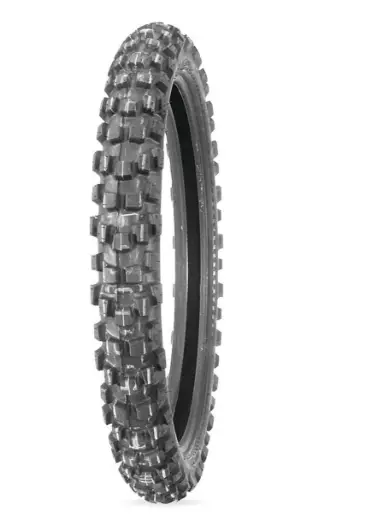
Tire:
Front: https://www.amazon.com/dp/B000GRSH84
Rear: https://www.amazon.com/dp/B000GZIG0K
The Dunlop tires you’ve linked are known for their versatility, offering strong performance both on and off-road. Here are the features, benefits, pros, and cons:
Features with Benefits:
Off-road Performance: These Dunlop tires are designed to excel in off-road conditions, providing traction and control on various surfaces such as dirt, gravel, and mud. Riders can confidently tackle challenging terrain, including trails and rocky paths, with these tires.
Great Traction on Asphalt:
Despite their off-road capability, these tires also offer excellent traction on asphalt. This allows riders to enjoy stable and predictable handling on paved roads, making them suitable for commuting, touring, and highway riding.
Great Replacement for Factory Tires:
The Dunlop tires serve as a great replacement for factory-installed tires, often offering improved performance and durability. Riders can upgrade to these tires for enhanced off-road capability and overall riding experience.
Full-Depth Tread Pattern:
The full-depth tread pattern ensures consistent performance throughout the life of the tire. This means that even as the tire wears down, riders can continue to rely on its traction and stability, maximizing its lifespan and value.
DOT-Approved Full Knobby Tire:
These tires are DOT-approved, meaning they meet the safety and performance standards set by the Department of Transportation. Despite their knobby design for off-road performance, they are legal for street use, providing riders with versatility for both on and off-road adventures.
Pros:
- Long-lasting;
- Excellent highway durability and grip;
- Suitable for street driving beside off-roading;
- Premium performance in a wide range of terrain;
Cons:
- May produce some road noises.
- Kawasaki 1985-2016: Best for Quality, Fitment, and Durability
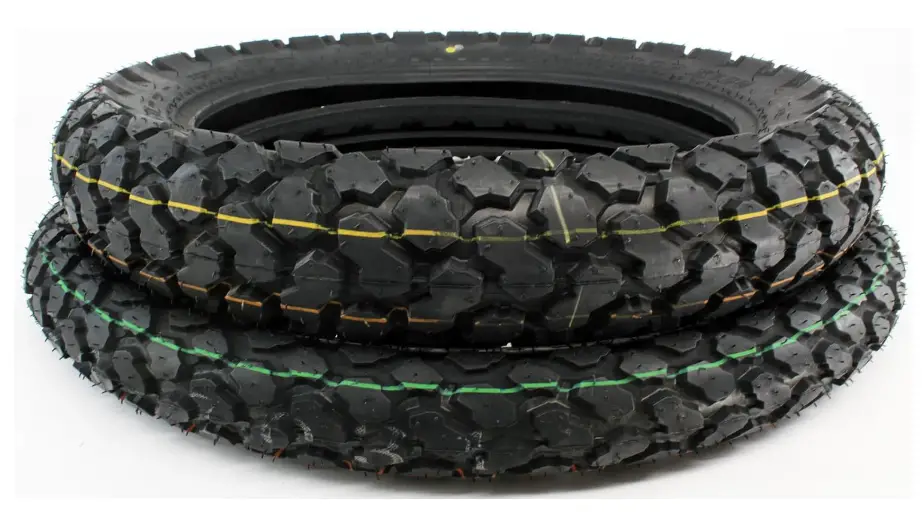
For Kawasaki motorcycles spanning from 1985 to 2016, a wide array of tires cater to diverse riding needs. With options tailored to both on-road and off-road adventures
Features with Benefits:
Non-Directional Tread Type:
The non-directional tread pattern provides versatility by offering consistent performance regardless of the tire’s rotation direction.
This means the tire can be mounted in either direction without affecting its grip or handling characteristics, simplifying installation and replacement.
Great Quality:
This tire is known for its high-quality construction and materials, ensuring durability and reliability in various riding conditions.
Riders can expect consistent performance and longevity from this tire, making it a dependable choice for both daily commuting and longer journeys.
OEM Tire:
As an Original Equipment Manufacturer (OEM) tire, this product is designed to meet the specifications and standards set by Kawasaki for their motorcycles.
This ensures compatibility and optimal performance when used as a replacement tire on Kawasaki models from 1985 to 2016.
Easy to Mount:
The tire is designed for easy mounting, allowing riders to replace their worn-out tires quickly and efficiently. Whether performing the replacement themselves or seeking assistance from a professional mechanic, the straightforward mounting process minimizes downtime and hassle.
Sealed Drive Chain:
Some Kawasaki motorcycles feature a sealed drive chain, which offers several benefits including reduced maintenance requirements, increased longevity, and improved performance. The use of a sealed drive chain with this tire helps maintain optimal power transmission and efficiency while minimizing maintenance tasks for the rider.
Pros:
- Perfect fitting;
- Lower air pressure on the dirt;
- Year-round benefits;
- 584 pounds load capacity;
- Safely operates at speeds more than 93 MPH.
Cons:
- Bit louder than expected.
- Shinko 705 Tire: Best for Versatility
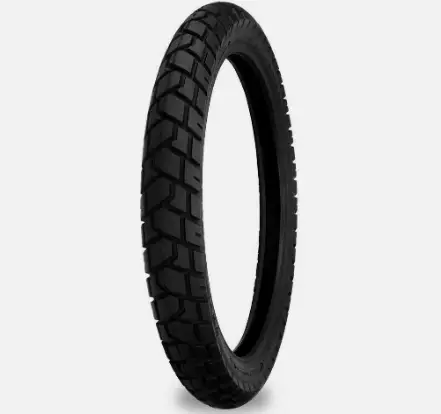
The Shinko 705 Tire is known for its versatility, offering a balance between off-road capability and on-road performance. Let’s explore its features, benefits, pros, and cons:
Features with benefits:
Rubber Compound Surrounding:
The rubber compound surrounding the tire provides enhanced durability and protection against punctures and abrasions. This feature ensures longevity and reliability, making the tire suitable for both on-road and off-road riding.
Designed for Off-road (30%) and On-road (70%):
The tire is designed to excel in both off-road and on-road conditions, with a tread pattern optimized for a 30% off-road and 70% on-road ratio. This balanced design allows riders to confidently tackle various terrains, including dirt trails, gravel roads, and paved highways.
Dirt-oriented Tread Design:
The dirt-oriented tread design of the Shinko 705 Tire provides excellent traction and control in off-road environments. The aggressive tread pattern features large blocks and deep grooves to grip loose surfaces such as dirt, mud, and gravel, ensuring stability and confidence for riders.
DOT Approved:
The tire is DOT-approved, meaning it meets the safety and performance standards set by the Department of Transportation. This ensures legality for street use and confirms that the tire has undergone testing for safety and reliability on paved roads.
Versatile Tread Pattern:
The versatile tread pattern of the Shinko 705 Tire allows for reliable performance in a wide range of conditions. Whether navigating city streets, touring on highways, or exploring off-road trails, riders can count on consistent grip and handling from this tire.
Pros:
- Smooth running on the highway;
- Excellent dry and wet weather adhesion;
- Good traction and mileage;
- Great for the money.
Cons:
- Hard rubber compounds may not be good on wet roads.
- Kawasaki 1985-2018: Best for Compatibility and Quality
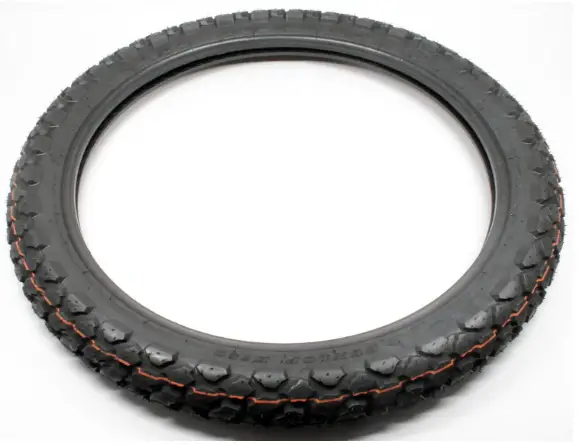
Front: https://www.amazon.com/dp/B01K14CKSE
Rear: https://www.amazon.com/dp/B01K14CNXG
Spanning from 1985 to 2018, Kawasaki motorcycles offer a rich legacy of performance and versatility. With tire options designed to match the diverse needs of riders.
Features with benefits:
Non-Directional Tread Type:
The non-directional tread pattern offers versatility by providing consistent performance regardless of the tire’s rotation direction. This simplifies installation and replacement, as riders do not need to worry about tire orientation.
Year-Round Compatible:
These tires are designed to be compatible with year-round riding, offering reliable performance in various weather conditions. Whether riding in dry, wet, or mixed conditions, riders can trust these tires to provide grip and stability throughout the year.
New OEM Tire:
As new OEM tires, these products are designed to meet the specifications and standards set by Kawasaki for their motorcycles. This ensures compatibility and optimal performance when used as replacements, offering riders the same quality and performance as the original tires.
Pros:
- Reliable;
- Quality assurance;
- Easy replacement.
Cons:
- OEM tires may offer limited choices.
5 Types Of Tires For The Klr650:
For the Kawasaki KLR650, various types of tires are available to suit different riding preferences and terrain conditions. Here are some common types of tires for the KLR650:
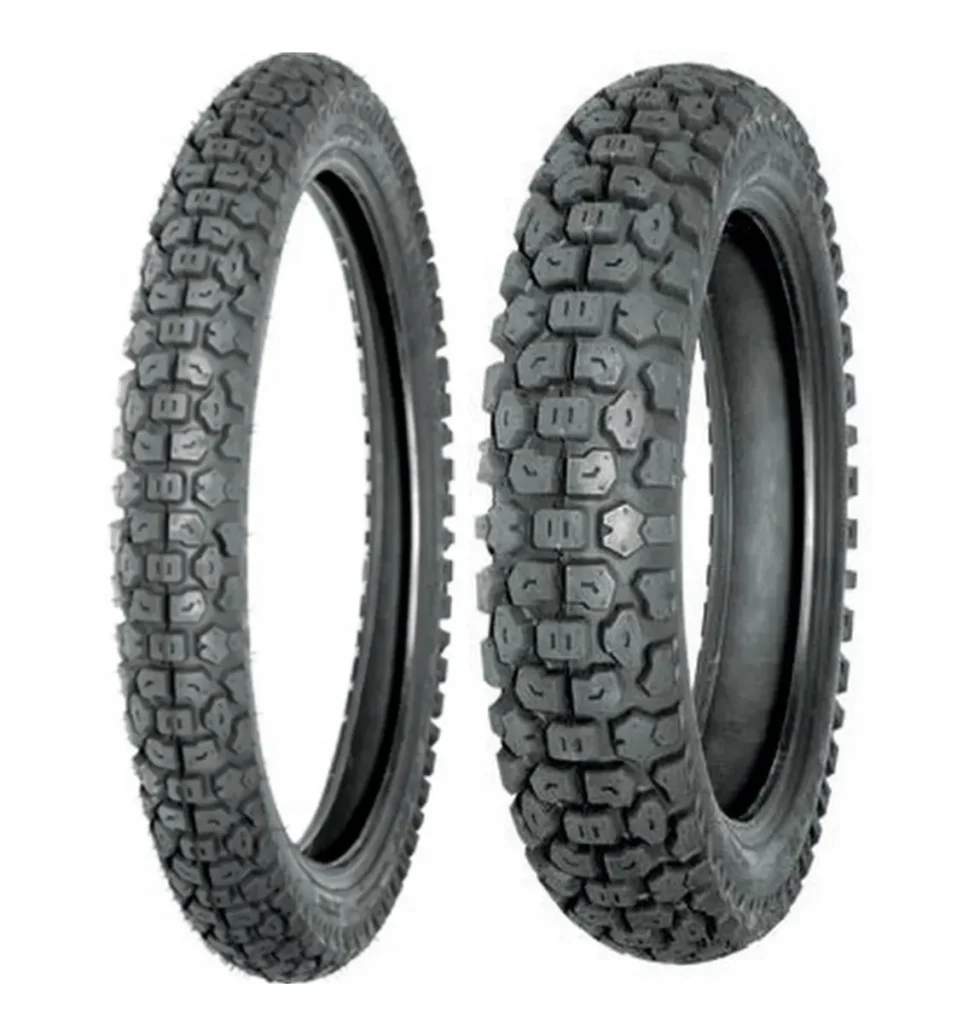
- Dual-Sport Tires:
These tires are designed to offer a balance between on-road and off-road performance, making them versatile for riders who enjoy both types of riding.
They typically feature a tread pattern that incorporates elements from both street and off-road tires, providing decent traction on paved surfaces as well as dirt and gravel roads.
Dual-sport tires often have a stiffer sidewall construction to handle the demands of off-road riding while still maintaining stability on the road.
- Adventure Touring Tires:
Adventure touring tires are primarily designed for long-distance touring on a variety of road surfaces, including highways, backroads, and light off-road trails.
These tires prioritize on-road performance and comfort while still offering some capability for off-road riding.
They feature a more street-oriented tread pattern with smaller, less aggressive knobs compared to dual-sport or off-road tires, providing better grip and stability on paved surfaces.
- Off-Road Knobby Tires:
Off-road knobby tires are specifically designed for aggressive off-road riding and provide maximum traction in challenging terrain.
They feature large, deep knobs spaced widely apart to dig into loose surfaces such as mud, sand, and rocks, offering superior grip and control.
These tires have a softer rubber compound and flexible sidewalls to conform to uneven surfaces and absorb impacts, enhancing off-road performance.
- All-Terrain Tires:
All-terrain tires are versatile tires that aim to provide a balance between on-road and off-road performance, making them suitable for a wide range of riding conditions.
They feature a tread pattern that combines elements of street and off-road tires to offer good traction and stability on various surfaces, including pavement, gravel, and packed dirt.
All-terrain tires typically have a more rounded profile and intermediate tread depth compared to dedicated off-road or street tires, providing a compromise between grip and longevity.
- Street Tires:
Street or road tires are designed primarily for on-road riding and offer the best grip, stability, and longevity on paved surfaces.
They feature a smooth tread pattern with minimal tread depth to maximize contact with the road and optimize handling and braking performance.
Street tires have a harder rubber compound and stiffer sidewalls to withstand the higher speeds and cornering forces encountered on highways and city streets.
10 Factors to Consider When Choosing Tires:
Here are 10 factors to consider when choosing the best tires for your Kawasaki KLR650, along with detailed explanations for each factor:
- Terrain Compatibility:
Assess the specific terrains you’ll traverse: hard-packed dirt, loose gravel, sand, mud, or asphalt. Opt for tires with versatile tread patterns and durable compounds if you encounter a mix. For predominantly off-road use, prioritize aggressive knobs for traction.
- Tread Pattern:
Consider the design elements of the tread pattern: knob size, shape, and spacing. Larger, more widely spaced knobs excel in mud and loose terrain, while smaller, closely spaced knobs provide better grip on hard-packed surfaces. Symmetrical patterns offer versatility, while directional patterns optimize traction in specific conditions.
- Durability:
Inspect the tire’s construction, focusing on sidewall strength, rubber compound hardness, and tread depth. Reinforced sidewalls and durable compounds resist punctures and abrasions, while deeper treads provide extended mileage. Look for features like sipping for enhanced wet traction and self-cleaning grooves for debris clearance.
- Size and Fitment:
Prioritize compatibility with your motorcycle’s specifications: rim size, width, and diameter. Consult the manufacturer’s guidelines to ensure precise fitment and avoid issues like clearance or rubbing against fenders or swingarms. Incorrect fitment can compromise handling and safety.
- Weight Rating:
Determine the tire’s maximum load capacity, factoring in your weight, passenger weight, luggage, and accessories. Choose tires with weight ratings that comfortably exceed your total load to maintain stability, traction, and longevity. Underloading or overloading tires can lead to premature wear or handling issues.
- Speed Rating:
Understand the tire’s speed capabilities, which indicate its safe operating range. Consider your typical riding speeds and select tires with speed ratings that accommodate those velocities. Exceeding the tire’s speed rating can compromise stability, traction, and safety, particularly at high speeds.
- Brand Reputation:
Research the manufacturer’s reputation, focusing on factors like reliability, consistency, and customer satisfaction. Investigate reviews, ratings, and testimonials from fellow riders to gauge the brand’s track record. Established brands with a history of quality products and excellent customer support inspire confidence.
- Price and Value:
Evaluate the overall value proposition, considering factors like initial cost, long-term durability, and performance. While budget-friendly options may offer immediate savings, higher-priced tires often deliver superior longevity, traction, and ride quality. Assess warranty coverage, return policies, and customer support for added value.
- Riding Style and Preferences:
Tailor your tire choice to your riding habits, preferences, and intended use. If you frequently venture off-road, prioritize tires with aggressive tread patterns and durable compounds. For long-distance touring, opt for tires with excellent stability, comfort, and mileage. Consider your preferred riding environment, whether it’s urban streets, mountain trails, or open highways.
- Seasonal Considerations:
Consider seasonal variations in weather and road conditions. Choose tires optimized for the predominant climate in your region: all-season tires for year-round use, winter tires for cold and wet conditions, or summer tires for warm and dry weather. Look for features like silica compounds for enhanced grip on wet surfaces and siping for improved traction on icy roads.
Related Questions:
What Tread Pattern Is Best For The Klr650?
The best tread pattern for the Kawasaki KLR650 depends on your riding preferences and the terrain you’ll encounter. For primarily off-road riding, an aggressive tread pattern with large knobs provides maximum traction in challenging terrain like mud, sand, and rocks.
However, if you’ll be riding mostly on paved roads with occasional off-road excursions, a smoother tread pattern with smaller knobs offers better handling and stability at higher speeds while still providing adequate grip on dirt trails.
Ultimately, choose a tread pattern that matches your riding style and the conditions you’ll encounter most frequently.
Are OEM Kawasaki tires a good option for the KLR650
OEM Kawasaki tires can be a reliable option for the KLR650. They are specifically designed and tested for compatibility with the motorcycle, offering assurance of quality and performance straight from the manufacturer.
They may lack some specialized features of aftermarket tires. However, OEM tires provide a convenient and straightforward choice for riders who prioritize compatibility and assurance of fitment.
Conclusion
Among these options, the Tusk Dsport® Adventure Tire stands out for its balance of performance and affordability, making it an attractive choice for budget-conscious riders. Its aggressive tread pattern and durable construction provide reliable traction both on and off-road.
For riders seeking premium performance and versatility, the Michelin Anakee Wild offers superior grip, durability, and all-terrain capabilities. Its advanced features make it ideal for adventure touring and tackling diverse riding conditions.
Besides, OEM Kawasaki tires provide a reliable and straightforward option, ensuring compatibility and peace of mind straight from the manufacturer.


